By:
- Christine Clark
Published Date
By:
- Christine Clark
Share This:
A Safe Start for Back to School
Campus mitigates COVID-19 virus transmission during its 10-day undergraduate move-in for nearly 6,000 students
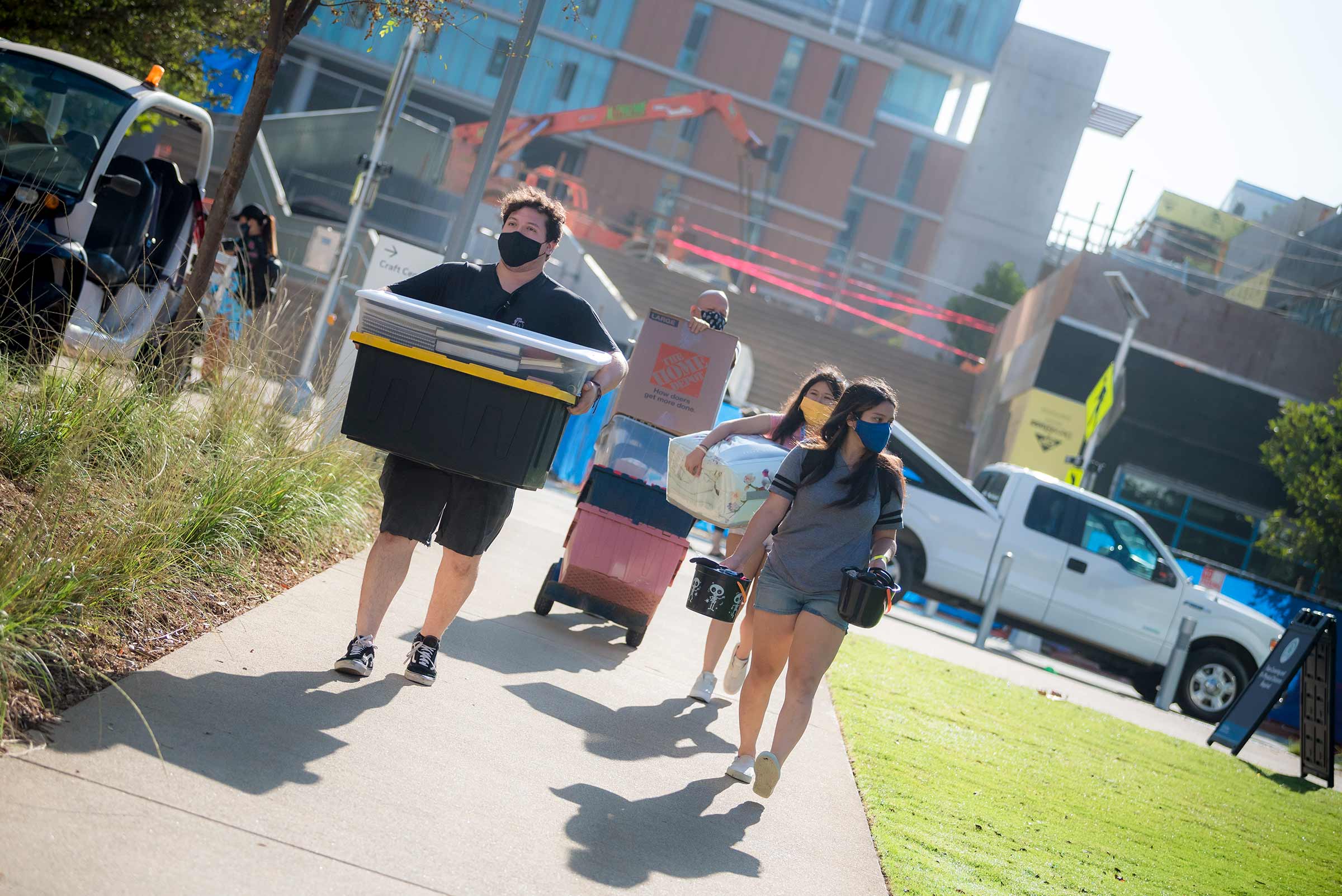
Photos by Erik Jepsen/UC San Diego Communications
UC San Diego’s in-person activities are off to a safe start under the campus’ Return to Learn program. With the beginning of the fall quarter on Sept. 28, 5,730 undergraduate students moved on campus over a 10-day period beginning Sept. 19. The university mapped out a staggered move-in process to allow for physical distancing as well as mandatory testing, all in an effort to provide a world-class education to students amidst the COVID-19 pandemic.
At the time of student move-in, the UC San Diego Center for Advanced Laboratory Medicine (CALM) averaged 1,500 tests daily for two weeks straight. Most test results were returned the next day, with an average turnaround of 15 hours.
Thousands of tests were administered to students over the 10 days, of which only 10 students tested positive and more than 5,700 tested negative.
These students were found to be asymptomatically shedding the virus, equating to a positivity rate of 0.17% out of the nearly 6,000 undergraduates who moved on campus. These students received clinical guidance and were promptly moved to isolation housing (the university currently has more than 600 beds to accommodate such needs). They will move back into their general campus housing as soon as they are no longer potentially infectious to others.
Seven additional students, no longer infectious, with a recent prior history of COVID-19 also moved onto campus during this period. Students without a recent prior history of COVID-19 will undergo a second test in two weeks to identify students who may develop viral shedding from an exposure in the 14-day viral incubation period window prior to arriving on campus.
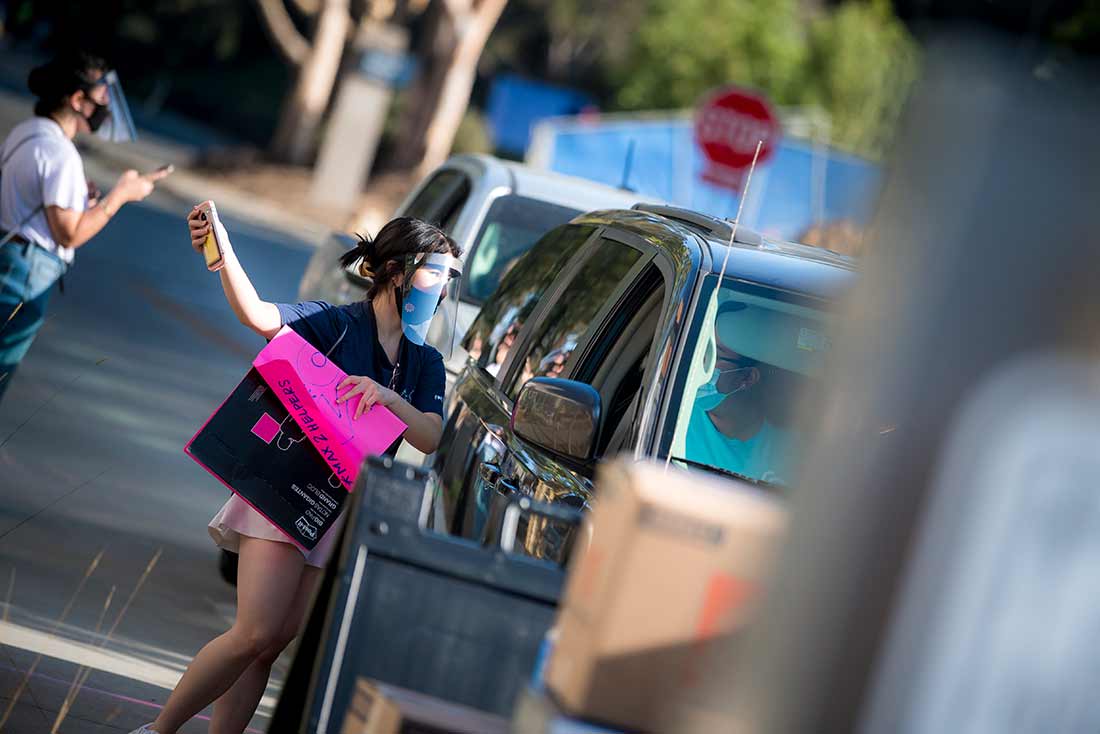
At the time of student move-in, the UC San Diego Center for Advanced Laboratory Medicine (CALM) averaged 1,500 tests daily for two weeks straight.
Move-in is just one part of UC San Diego’s nationally recognized, evidence-based comprehensive safety program to incrementally return to in-person activities on campus. The plan includes face-covering requirements, frequent asymptomatic and symptomatic testing, wastewater monitoring, case isolation, exposure notification and contact tracing, aided by the use of a new app that lets users know if they’ve had contact with infected people. Additionally, the campus is maintaining a low-density population. Approximately 7 percent of classes are in-person with 22 percent of students registered in at least one of these classes, and the rest taking advantage of online offerings.
“Since mid-March, UC San Diego has relied on the expertise of our world-renowned faculty and medical doctors to thoughtfully plan for returning to in-person teaching and research on campus in the safest way possible,” said Chancellor Pradeep K. Khosla. “We were the first university to announce a commitment to incrementally repopulating our campus, and we have taken the necessary time to develop a flexible ‘Return to Learn’ plan to do so prudently.
“Our Return to Learn approach is guided by three key pillars: risk mitigation, virus detection and intervention. During the spring and summer, we successfully tested this approach on our campus with limited number of students, researchers, faculty and staff. This approach is currently working very well for our campus,” Khosla added. “With that said, the adaptability of our plan is key to our continued success. If necessary, our campus operations will shift should we see significant changes in the public health of our campus or of the larger San Diego community.”
In addition to guidance from public health agencies, the Return to Learn program is driven by the expertise from the UC San Diego School of Medicine and Wertheim School of Public Health and Longevity Science and health care experts from UC San Diego Health.
Detailed safety protocols during move-in
Students registered for move-in times in advance of the week and were allowed to be accompanied by up to two people for support. All students living on campus reside in apartments or residence hall suites and have their own bedrooms. As students and families arrived in their vehicles, they were greeted, given a welcome kit and screened by Health Promotion staff to ensure they and their family were wearing the required masks and were without symptoms. Following this step, the students participated in drive-through testing for SARS-CoV-2 and were allowed to proceed to their residential area. Walk-up testing was available as well.
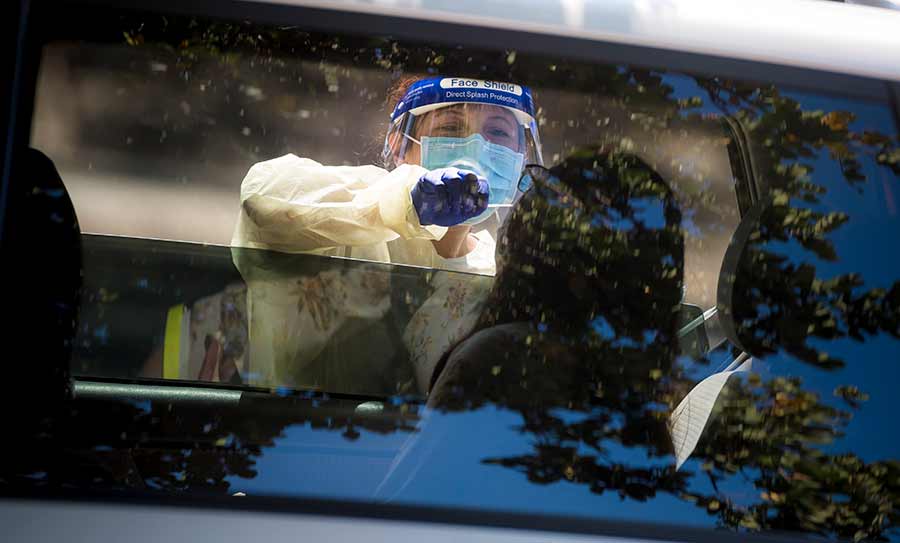
As students and families arrived in their vehicles, they participated in drive-through testing for SARS-CoV-2 and were allowed to proceed to their residential area. Walk-up testing was available as well.
Move-in was staggered to avoid congestion at the residential units. While tests results have been available within less than 24 hours, students continue to remain masked (except when showering or when alone in their personal bedroom) and maintain social distancing over the next two weeks while others continue to arrive.
Twelve days after the last student arrives at their apartment, all the residents of the unit are retested. If all test results are negative, students no longer need to wear their masks and maintain strict distancing within their residential unit.
All UC San Diego students residing on campus or coming to campus for any reason will be required to have testing for SARS-CoV-2 twice a month throughout the academic year. Each test is at least 12 days apart, with no more than 16 days between tests.
“We are proud of our students who have been masking, following public health guidelines and making sacrifices to keep themselves and our community safe,” said Alysson M. Satterlund, Vice Chancellor for Student Affairs. “We know we ask a lot of our students in these difficult times. But we also are dedicated to helping students achieve health and success, by providing access to tools to support students’ academic, social, cultural and well-being needs.”
Cutting-edge wastewater monitoring
Wastewater monitoring is also part of the campus’ viral detection strategies. UC San Diego has been testing sewage for more than a month from two health facilities, a research building, and the Revelle College residence area. These efforts have already proven helpful in identifying individuals shedding virus and potentially exposing others. The virus was detected on Sept. 4 from the waste stream in the Revelle area, and prompt messaging notified those on campus of the situation, urging them to be tested as soon as possible. More than 657 campus community members responded by getting screened for the virus within three days. The process helped identify two asymptomatic employees who self-isolated.
The campus will scale up wastewater testing considerably in the coming months, through advanced technologies provided by the Knight Lab within the campus’ Center for Microbiome Innovation.
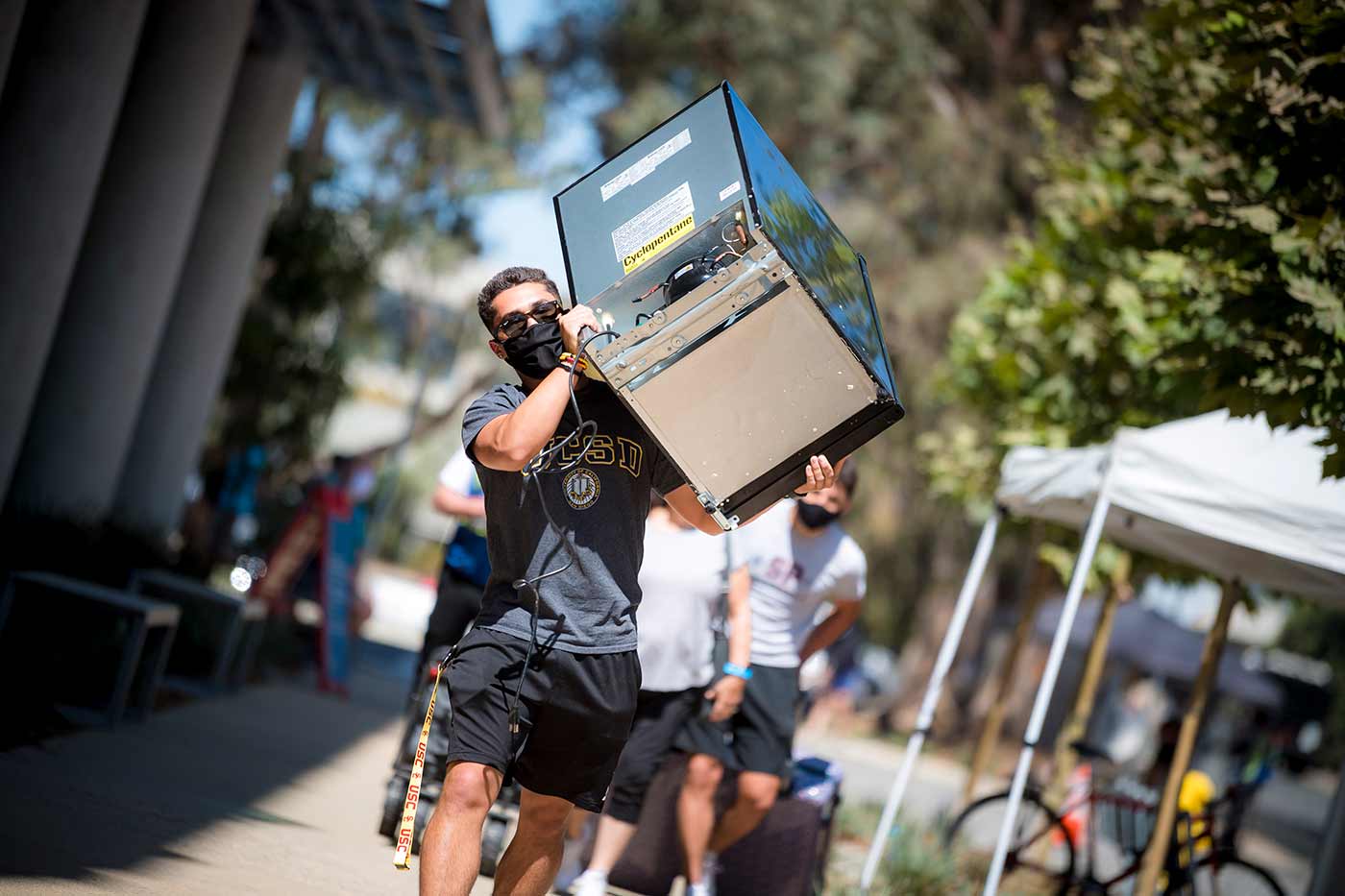
Students on campus have been masking, following public health guidelines and making sacrifices to keep themselves and our community safe.
Fighting COVID-19 with technology
Contact tracing is another vital part of the Return to Learn plan, and the campus is leveraging new technology on Apple and Android smartphones to help rapidly control COVID-19 outbreaks. Students and staff can voluntary opt-in to an anonymous exposure notification system that lets users know if they have come into contact with someone who later tests positive for COVID-19.
For every person who adds and uses the notification system on their smartphone, the greater the possibility of quick detection. Thus far, an estimated 11,000 people at UC San Diego have added the notification system, which augments existing contact tracing efforts on campus. This voluntary program is the first pilot for the State of California, and will be followed by UC San Francisco. If the pilot is successful, it will set the foundation for the state to offer voluntary exposure notifications to all Californians using smartphone-based technology. By some estimates, for every two users of the system, one potential COVID-19 infection could be stopped.
The power of peer education to prevent viral transmissions
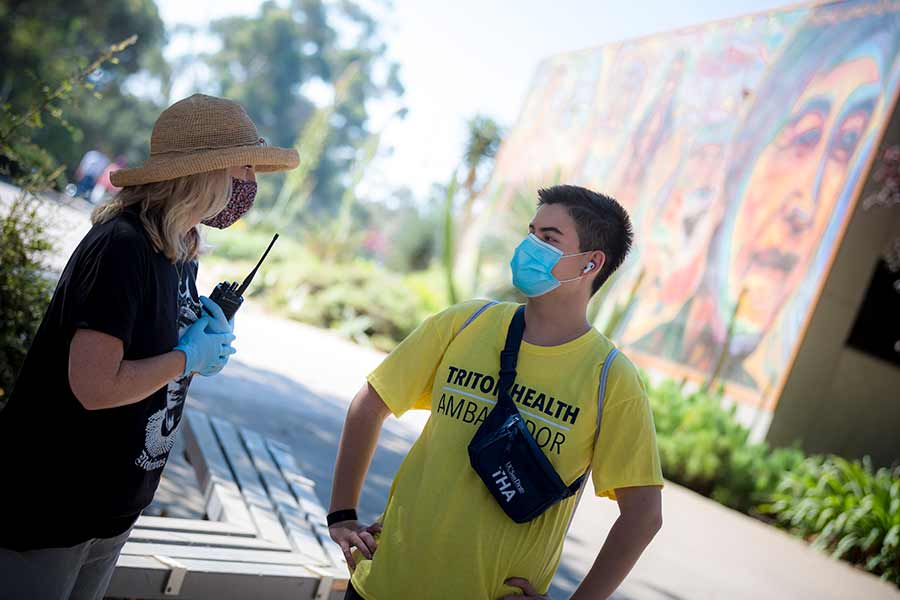
More than 200 peer educators called Triton Health Ambassadors are working to educate students on the importance of wearing masks and staying six feet apart.
More than 200 peer educators called Triton Health Ambassadors are working to educate students on the importance of wearing masks and staying six feet apart. In addition, resident advisors (RAs) have been trained in health and safety best practices. Together, the Ambassadors and RAs have helped welcome and support students during the move-in process.
Brasilia Perez, Senior RA for Sixth College, was on-hand as students moved into the college’s new space at the North Torrey Pines Living and Learning Neighborhood.
“Being a Senior RA during move-in, in a brand new neighborhood, during COVID-19 has been exciting, nerve-wracking, busy and anything but boring,” said Perez. “In order to open Sixth in the safest way possible, it has taken each individual on the team to demonstrate impressive amounts of grace and patience. I am so proud to be opening up Sixth College at North Torrey Pines Living and Learning Neighborhood with the professional staff, custodial staff, interns, resident advisors and fellow student resident advisors that make up my team.”
Share This:
You May Also Like
UC San Diego is Strengthening U.S. Semiconductor Innovation and Workforce Development
Technology & EngineeringStay in the Know
Keep up with all the latest from UC San Diego. Subscribe to the newsletter today.



